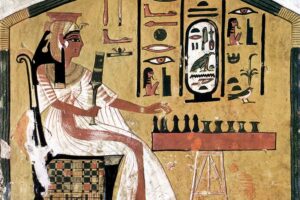The ancient Olympic Games were a religious festival where only men were admitted – both as participants and spectators.
However, women were able to gain a small part in the games in one way: By owning a horse-drawn carriage that took part in races.
Princess Cynisca of Sparta won twice when her chariot crossed the finish line first in 396 BC. and 392 BC But the rules meant she probably wasn’t allowed to be there to enjoy the win.
However, women had their own sporting event. The so-called Heraia games were named after the goddess Hera and also took place in Olympia.
There, young unmarried women competed with each other.
Women competed in a race
Women are mentioned for the first time in the fifth century BC. Heraia only consisted of the Stadi on race where three age groups were contested.
The race was also part of the men’s games, but the women’s distance was somewhat shorter. And unlike the men, the women did not run naked.
They wore the so-called Khiton which covered part of the body but not the right shoulder and chest.
When the Olympic Games were held again for the first time since ancient times in 1896, women were still excluded.
But after much criticism, women were allowed to participate from 1900, although only in so-called women’s sports such as tennis and riding. Gradually, women were allowed to participate in more competitions.






